For five months, the relationships intensified, spawning affection as well as insight.

But for fifth-graders at Pocopson Elementary School, breaking up wasn’t so hard to do on Friday, April 1 – even when the results turned from fun to fatal.
“He’s swimming away to a better life,” one girl exclaimed as her fingerling brook trout darted away in the Pocopson Creek.
“Mine died,” one boy lamented. “A bigger fish ate him right after I let him go.”
But the day’s packed schedule allowed no time for mourning. Besides, the earlier rains had unleashed a plethora of worms, and the excited students from Dave Lichter’s class quickly scooped them up and dropped them into the water. Periodically, a splash marked the spot where a larger fish enjoyed the feast.
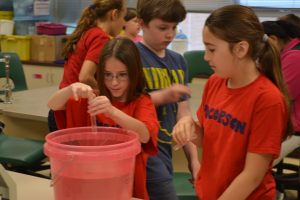
The exercise was but one facet of Trout in the Classroom, an interdisciplinary national program in which students learn about cold-water conservation while raising brook trout from eggs to fingerlings in a classroom aquarium. Pennsylvania's TIC program exists through a partnership between Pennsylvania Council of Trout Unlimited and the Pennsylvania Fish and Boat Commission.
At Pocopson, the fifth-graders enjoyed a full morning of fish-related activity, rotating through four stations. The half-hour sessions included a presentation by the Stroud Water Research Center, a demonstration of fly-tying, fish-related art projects, and the coveted release.
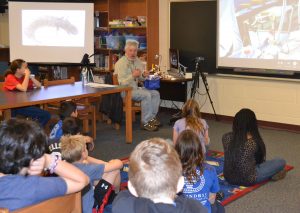
Laurie Swisher’s class began its day by exploring the science of healthy waterways. Steve Kerlin, Stroud’s director of education, involved the students in testing the water at the site where the fingerlings were being set free. He received assistance from Dave Dickens, who retired in 2005 as Unionville High’s principal and now enjoys working part-time with Stroud.
Kerlin told the students he was very impressed with their success in raising the fish. “Yours are bigger, and you have more than we do [at Stroud],” he said, acknowledging that Stroud’s collection experienced a setback during holiday vacations.

At Pocopson, the custodial staff ensured that the baby fish were fed when school wasn’t in session, but that didn’t mean that the experience was trouble-free. “Our fish had a problem with the nitrate level,” one girl volunteered.
Kerlin explained why that’s not unusual and how to remedy it, describing the damage that fertilizer runoff can cause. He also led the students through a series of tests from pH to nitrites, watching as the young scientists assessed their results.
Nearby in the library, Terry Peach from A Marblehead Flyfisher Inc. in Centreville, Del., showed students how to create lures from natural materials that mimic nature, thereby fooling the fish – but not for long. “We always do catch and release,” he said. “We want them to live so they get to fight another day.”
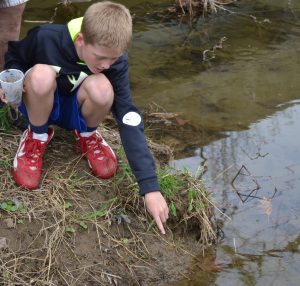
As Peach worked his artistry, describing the process as he added rabbit fur to one lure, the students got the benefit of two screens. One displayed an image of the particular insect Peach was replicating, and one magnified his work space so that all the students could see exactly what he was doing. Once he finished a lure, he passed it around so students could view its intricacy up close.
Fifth-grade teacher Linda Bowman said she enjoyed Peach’s ability to connect with the students. “It’s so fun to watch,” she said. “He’s so engaging; the kids are mesmerized.”

At the school’s Cool Bean Café, groups of fifth-graders were equally fixated as they put finishing touches on their foil-punch fish drawings. They also snacked on goldfish crackers. “Wasn’t that a great idea?” asked Lichter, who credited his colleague, fifth-grade teacher Barbara Williamson, for providing the tasty, themed treat.
Eileen Day, one of the parents assisting with the art activities, said her daughter Maddie had been eagerly awaiting release day. “She’s been talking about this since the eggs came,” her mother said.
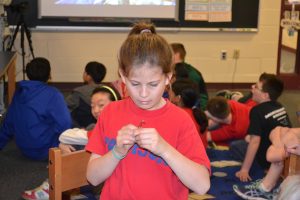
Lichter said the students managed to raise about 200 fingerlings from the 317 eggs that arrived in November, an exciting achievement. During that time, the students monitored the temperature, acidity, ammonia, nitrate and nitrite levels of the water.
Dave Macaleer, a member of the Valley Forge chapter of Trout Unlimited, said he valued the program’s positive impact. “It’s never too early to teach kids about the importance of conservation and the importance of our environment,” he said.

Plus, it was gratifying to see the results as the students gently coaxed their fish into the creek. “Basically we’re here for the kids,” Macaleer said. “Release day is a lot of fun.”
A few minutes earlier, he had watched as students eagerly swarmed the fish distributors: Ryan Stephens, a fourth-grade teacher, and Andy Lefko, the fifth-grade learning support teacher.
“Be careful: We’ve had some jumpers,” warned Stephens as he handed each student a small plastic cup containing a couple of the approximately two-inch fingerlings. Some students even gave them names, covering the top of the container, just in case a fish got feisty.

“Get as close to the water as you can without going in,” said Stephens. “And remember that they went from a 55-gallon tank to a five-gallon bucket to an eight-ounce cup. They’re going to be a little shocked.”
But the bigger shock likely belonged to the adults. Despite some knee-deep mud, which behaved like quicksand in a couple of spots, the group of fifth-graders managed to keep their footing.

For those who would like to duplicate the experience, the Stroud Water Research Center is hosting the "Trout Grow on Trees Family Outing" on Saturday, April 23, starting at 10 a.m. at the White Clay Creek Preserve. And for the uninitiated, Kerlin can explain the symbiotic significance of the event's title: Insects eat the leaves from the trees, and the fish dine on the insects.
For more information about "Trout Grow on Trees," contact Tara Muenz at 610-268-2153, ext. 301, or tmuenz@stroudcenter.org or visit www.stroudcenter.org. More information on Trout in the Classroom can be found here.
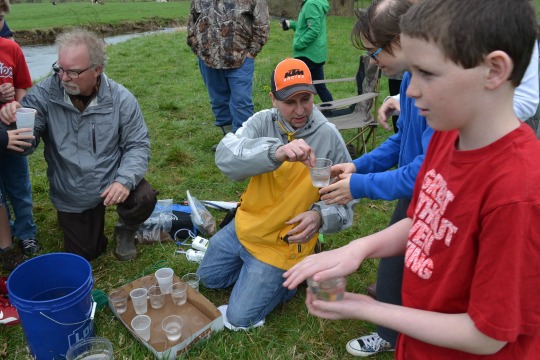



Comments